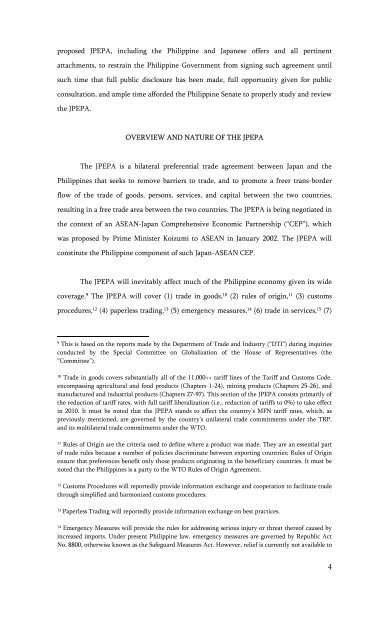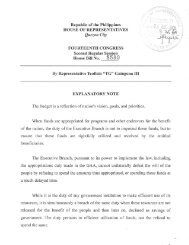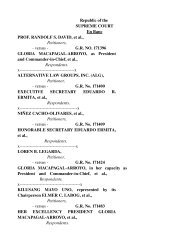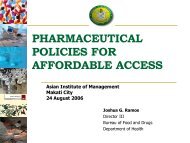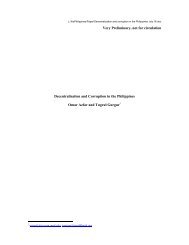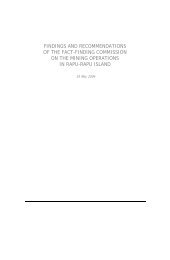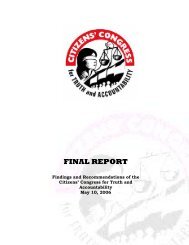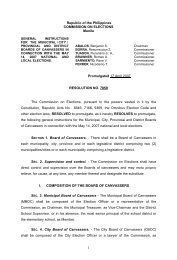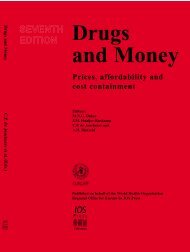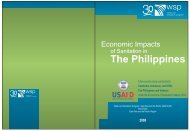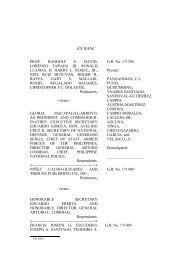here - Philippine Center for Investigative Journalism
here - Philippine Center for Investigative Journalism
here - Philippine Center for Investigative Journalism
You also want an ePaper? Increase the reach of your titles
YUMPU automatically turns print PDFs into web optimized ePapers that Google loves.
proposed JPEPA, including the <strong>Philippine</strong> and Japanese offers and all pertinent<br />
attachments, to restrain the <strong>Philippine</strong> Government from signing such agreement until<br />
such time that full public disclosure has been made, full opportunity given <strong>for</strong> public<br />
consultation, and ample time af<strong>for</strong>ded the <strong>Philippine</strong> Senate to properly study and review<br />
the JPEPA.<br />
OVERVIEW AND NATURE OF THE JPEPA<br />
The JPEPA is a bilateral preferential trade agreement between Japan and the<br />
<strong>Philippine</strong>s that seeks to remove barriers to trade, and to promote a freer trans-border<br />
flow of the trade of goods, persons, services, and capital between the two countries,<br />
resulting in a free trade area between the two countries. The JPEPA is being negotiated in<br />
the context of an ASEAN-Japan Comprehensive Economic Partnership (“CEP”), which<br />
was proposed by Prime Minister Koizumi to ASEAN in January 2002. The JPEPA will<br />
constitute the <strong>Philippine</strong> component of such Japan-ASEAN CEP.<br />
The JPEPA will inevitably affect much of the <strong>Philippine</strong> economy given its wide<br />
coverage. 9 The JPEPA will cover (1) trade in goods, 10 (2) rules of origin, 11 (3) customs<br />
procedures, 12 (4) paperless trading, 13 (5) emergency measures, 14 (6) trade in services, 15 (7)<br />
9<br />
This is based on the reports made by the Department of Trade and Industry (“DTI”) during inquiries<br />
conducted by the Special Committee on Globalization of the House of Representatives (the<br />
“Committee”).<br />
10<br />
Trade in goods covers substantially all of the 11,000++ tariff lines of the Tariff and Customs Code,<br />
encompassing agricultural and food products (Chapters 1-24), mining products (Chapters 25-26), and<br />
manufactured and industrial products (Chapters 27-97). This section of the JPEPA consists primarily of<br />
the reduction of tariff rates, with full tariff liberalization (i.e., reduction of tariffs to 0%) to take effect<br />
in 2010. It must be noted that the JPEPA stands to affect the country’s MFN tariff rates, which, as<br />
previously mentioned, are governed by the country’s unilateral trade commitments under the TRP,<br />
and its multilateral trade commitments under the WTO.<br />
11<br />
Rules of Origin are the criteria used to define w<strong>here</strong> a product was made. They are an essential part<br />
of trade rules because a number of policies discriminate between exporting countries; Rules of Origin<br />
ensure that preferences benefit only those products originating in the beneficiary countries. It must be<br />
noted that the <strong>Philippine</strong>s is a party to the WTO Rules of Origin Agreement.<br />
12<br />
Customs Procedures will reportedly provide in<strong>for</strong>mation exchange and cooperation to facilitate trade<br />
through simplified and harmonized customs procedures.<br />
13<br />
Paperless Trading will reportedly provide in<strong>for</strong>mation exchange on best practices.<br />
14<br />
Emergency Measures will provide the rules <strong>for</strong> addressing serious injury or threat t<strong>here</strong>of caused by<br />
increased imports. Under present <strong>Philippine</strong> law, emergency measures are governed by Republic Act<br />
No. 8800, otherwise known as the Safeguard Measures Act. However, relief is currently not available to<br />
4


